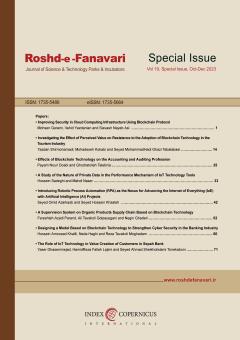A Supervision System on Organic Products Supply Chain Based on Blockchain Technology
Subject Areas : زيرساختهاي توسعه فناوري و نهادهاي پشتيبان توسعه فناوريFERESHTEHAZADI PARAND 1 * , َAli TAVAKOLIGOLPAYGANI 2 , Negin Ghaderi 3
1 - Allameh Tabataba'i
2 - Standard Research Institute
3 - Pars Quality Standard Inspection Co
Keywords: Organic Products, Blockchain, Supply Chain, Consensus Algorithms, Irreversibility,
Abstract :
Nowadays, based on the spreading of information technology, food consumers especially organic food increasingly want to be informed about the history of food products that they are buying. They want to know about the origin of food, the condition of storage, transporting, etc. besides the information are printed on the packages. In this paper, we are proposing a back and forth supervision system on organic products supply chain based on blockchain technology to ensure data integrity and allow data tracing. The proposed system as a decentralized and secure infrastructure database improves food security and safety, and reduces fraud by verifying the quality and the origin of the products throughout the entire their agricultural supply chain. A unique Quick Response code was used to identify each product within the supply chain. Automated protocols on validation each transaction and events related to a product by peers of the Blockchain system enable data transmitted on the network to be verified and stored immutably and minimizing the risk of data corruption.
1. Azzurra, A. Massimiliano, M. Angela, (2019). Measuring sustainable food consumption: A case study on organic food. Sustainable Production and Consumption, 17, 95–107.
2. Codex GL 32: 2013, Guidelines for the production, processing, labeling and marketing of organically produced foods.
۳. استاندارد ملی ایران به شماره ۱۱۰۰۰:۱۳۹۹ تحت عنوان استاندارد ( الزامات توليد، فرآوري، بازرسي و صدورگواهي، برچسب گذاري و بازار رساني مواد غذايي ارگانيك (زيستي)).
4. R. Bierbaum, S. Leonard, D. Rejeski, C. Whaley, R. Barra, C. Libre, Novel entities and technologies: environmental benefits and risks, Environ. Sci. Pol. 105 (2020) 134–143.
5. Ganne, E. 2018. Can blockchain revolutionize international trade? In: WTO [online]. Available: www.wto.org/english/res_e/publications_e/blockchainrev18_e.htm
6. PricewaterhouseCoopers (PwC). 2019. Blockchain is here. What’s your next move. In: PwC [online]. Available: www.pwc.com/blockchainsurvey
7. Ethereum. 2020. What is Ethereum. In: Ethereum [online]. Available at: https://ethereum.org/what-is-ethereum/
8. Wang, Y., Singgih, M., Wang, J., & Rit, M. (2019). Making sense of blockchain technology: How will it transform supply chains? International Journal of Production Economics, 211, 221–236.
9. Azzi, R., Chamoun, R. K., & Sokhn, M. (2019). The power of a blockchain-based supply chain. Computers & Industrial Engineering, 135, 582–592.
10. Hawlitschek, F., Notheisen, B., & Teubner, T. (2018). The limits of trust-free systems: A literature review on blockchain technology and trust in the@@ sharing economy. Electronic Commerce Research and Applications, 29, 50–63. https://doi.org/10.1016/j. elerap.2018.03.005.
11. Li, Z., Kang, J., Yu, R., Ye, D., Deng, Q., & Zhang, Y. (2017). Consortium blockchain for secure energy trading in industrial internet of things. IEEE Transactions on Industrial Informatics, 14(8), 3690–3700.
12. Sikorski, J. J., Haughton, J., & Kraft, M. (2017). Blockchain technology in the chemical industry: Machine-to-machine electricity market. Applied Energy, 195, 234–246.
13. Tian, F. (2016). An agri-food supply chain traceability system for China based on RFID and blockchain technology. International Conference on Service Systems and Service Management, 1–6.
14. Ahmed, S., & Broek, N. T. (2017). Food supply: Blockchain could boost food security. Nature, 550(7674), 43.
15. Lu, Q., & Xu, X. (2017). Adaptable blockchain-based systems: A case study for product traceability. IEEE Software, 34(6), 21–27.
16. Tönnissen, S., & Teuteberg, F. (2019). Analysing the impact of blockchain-technology for operations and supply chain management: An explanatory model drawn from multiple case studies. International Journal of Information Management. https://doi.org/ 10.1016/j.ijinfomgt.2019.05.009.
17. Behnke, K., & Janssen, M. F. W. H. A. (2019). Boundary conditions for traceability in food supply chains using blockchain technology. International Journal of Information Management. https://doi.org/10.1016/j.ijinfomgt.2019.05.025.
18. Saberi, S., Kouhizadeh, M., Sarkis, J., & Shen, L. (2019). Blockchain technology and its relationships to sustainable supply chain management. International Journal of Production Research, 57(7), 2117–2135. 19. Pan, X., Pan, X., Song, M., Ai, B., & Ming, Y. (2019). Blockchain technology and enterprise operational capabilities: An empirical test. International Journal of Information Management. https://doi.org/10.1016/j.ijinfomgt.2019.05.002.
20. FAO & International Telecommunication Union (ITU). 2019. E-agriculture in action: Blockchain for agriculture. Opportunity and challenges. Bangkok. 67 pp. Available at www.fao.org/3/CA2906EN/ca2906en.pdf.
21. FAO & World Health Organization (WHO). 2017. It’s time for fixed definitions for food fraud and food integrity. In: Codex Alimentarius [online].Rome. Available at www.fao.org/faowho-codexalimentarius/news-and-events/news-details/en/c/897028/
22. Wolfert, S., Ge, L., Verdouw, C., & Bogaardt, M.-J. (2017). Big data in smart farming – A review. Agricultural Systems, 153, 69–80.
https://doi.org/10.1016/j. agsy.2017.01.023.
23. Aung, M. M., & Chang, Y. S. (2014). Traceability in a food supply chain: Safety and quality perspectives. Food Control, 39, 172–184. 24. Olsen, P. & Borit, M. 2013. How to define traceability. Trends in Food Science & Technology, 29(2): 142–150.
25. Tzounis, A., Katsoulas, N., Bartzanas, T., & Kittas, C. (2017). Internet of things in agriculture, recent advances and future challenges. Biosystems Engineering, 164, 31–48. 26. Reyna, A., Martín, C., Chen, J., Soler, E., & Díaz, M. (2018). On blockchain and its integration with iot. challenges and opportunities. Future Generation Computer Systems, 88, 173–190.

